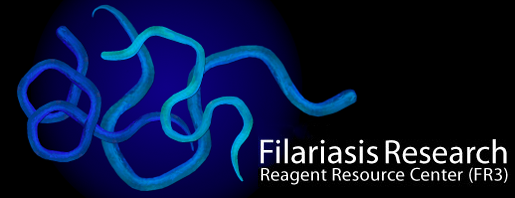Brugia Life Cycle, and Adults in Lymphatics
Lymphatic Filariasis caused by Brugia malayi is a vector borne disease. During a blood meal, an infected mosquito deposits third-stage filarial larvae (L3) onto the skin of the mammalian host, where they migrate and penetrate through the bite wound. In the mammalian host, they develop into female and male adults and reside in the lymphatics. In the experimental animal hosts, they can be found in heart, lungs and testes. The adult worms resemble those of Wuchereria bancrofti but are smaller. Female worms measure 43 to 55 mm in length, and males measure 13 to 23 mm in length. Female worms produce sheathed microfilariae (MF), measuring 177 to 230 μm in length and exhibit nocturnal periodicity. The MF migrate into lymph and enter the blood stream reaching the peripheral blood. Microfilariae are the diagnostic stages of infection and are responsible for infecting mosquitoes. Mosquitoes ingest the MF during a blood meal. After ingestion, the MF lose their sheaths and reach the thoracic muscles. There, MF develop into first-stage larvae and subsequently into third-stage larvae (L3s). The L3s migrate through the hemocoel to the mosquitoes proboscis and when these mosquitoes infected with L3s bite another mammalian host, the L3s enter the body to continue the life cycle. The third stage larvae (L3s) are the transmission stages of infection. The movie includes Brugia malayi female and male worms in culture medium, sheathed microfilaria in a blood sample and infective third stage larvae released from the mouth parts of Aedes aegypti (Liverpool strain) mosquito.
Movement of adult worms in the renal lymphatics of an infected gerbil.


